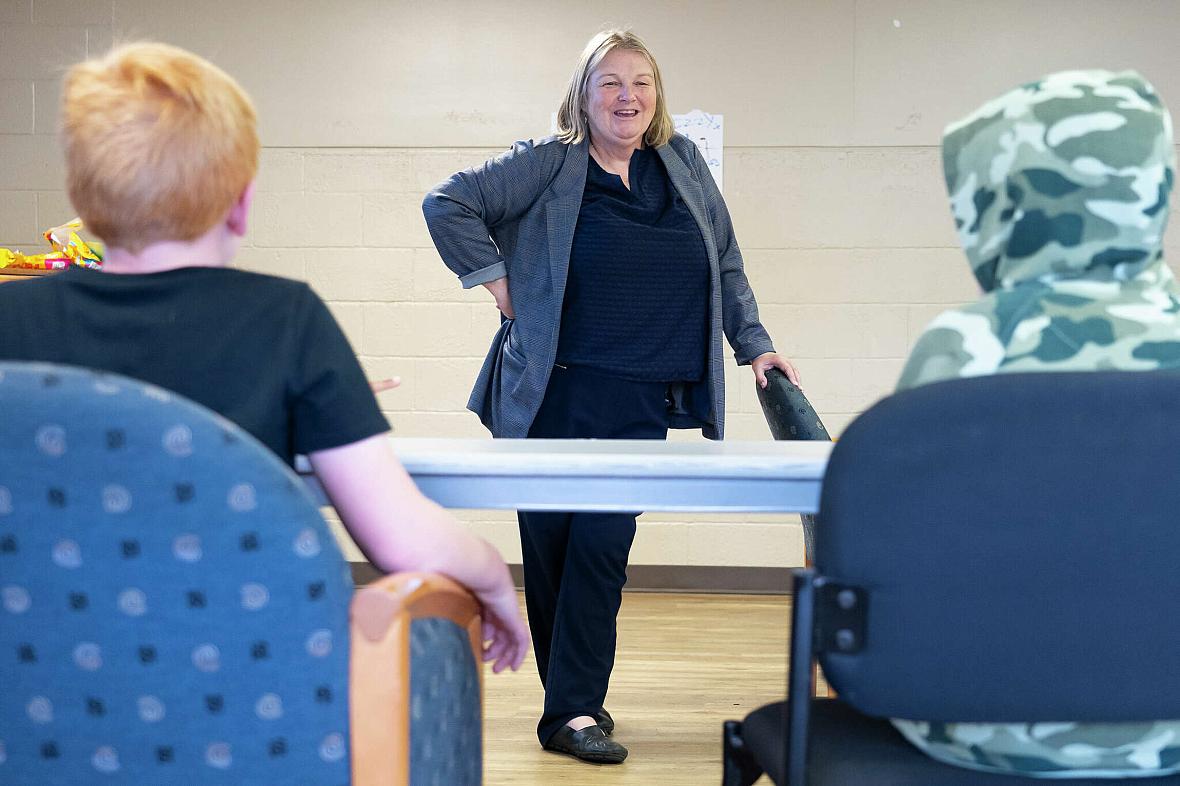How can schools provide mental health services for students? Here's one expert's recommendations.
This article was produced as a project for the USC Annenberg Center for Health Journalism's 2021 Data Fellowship.
Other stories in this project include:
PART 1: Texas schools don't have enough mental health providers, and leaders are failing to fix it
PART 2: ‘How did this happen to my son?’

Sanger ISD's director of student intervention, Ann Hughes, works with students in a social skills class at the Linda Tutt Learning Center, Tuesday, March 8, 2022, in Sanger. Sanger Independent School District has taken a holistic approach, beefing up its own resources and partnering with the community, creating one of the best-resourced districts in Texas.
Mark Mulligan/Staff photographer
A Houston Chronicle investigation found that at no point since 2013 did any Texas school district have the nationally or state recommended student-to-provider ratios in four positions that are key to providing mental health support for children - nurses, counselors, case workers and psychologists. School districts that spoke to the Chronicle said the problem was lack of funding. But one educator at Sanger ISD, Ann Hughes, has come up with solutions that, largely, do not cost money. Hughes, the district's director of Social Emotional Learning & Behavior Intervention, breaks down this effort into three tiers.
Hughes has more than 30 years of experience in education and is the director of student intervention for Sanger ISD. Hughes has worked in a variety of educational settings, including traditional classrooms, special education classrooms, residential treatment centers, juvenile correctional schools, therapeutic educational day treatment programs and alternative schools. She has a Ph.D. in special education from the University of North Texas.
She shared her strategy for creating effective school behavioral health programs with the Chronicle.
Tier 1
This level of care is for all students. Consider this prevention, like an annual doctor's appointment. This level of care will completely cover the needs of eighty percent of students.
Free:
School districts can develop, in conjunction with their counselors, a school-wide system to help students learn life skills to overcome challenges instead of punishing them for undesirable behavior. Schools can also use positive recognition for good behavior instead of singling out bad behavior. The Student Risk Screening Scale (SRSS), a free screener, also can be used to identify kids who are at risk for non-academic problems. Counselors, along with teachers, can incorporate behavioral health into the curriculum.
For this tier to work, Hughes says the program needs a champion on all campuses and the central office. Teachers and administrators should participate in any training on positive behavior reinforcement. Parents have a voice in determining school behavioral health policy and are offered training to continue these lessons at home.
Paid:
School districts can pay a one-time fee to purchase software programs, such as WhyTry or Ripple Effects, to teach kids how to cope with bullying, anxiety and unplanned change, for example, as well as how to manage their feelings and understand empathy. They also can set up separate rooms, such as movement rooms or relaxation rooms, where kids can go to regulate their emotions. These rooms cost Sanger ISD $6,000 per school.
Tier 2
This level of care is for about 15 percent of kids. Consider this like going to a specialist. These students still need to get Tier 1 support.
Free:
School districts can create small group counseling programs for those who are experiencing grief, for example, or bullying. They can encourage relationships with school counselors by having students join the counselor for "lunch groups." Teachers can let students use “Break Cards” that allow them to leave the classroom when they’re feeling overwhelmed without making a big deal about it. School-based jobs, such as working a coffee cart or peer mentoring, can also give at-risk kids a sense of purpose and accomplishment that they don’t receive elsewhere.
Paid:
School districts can identify kids who need time in the relaxation and movement rooms and can make sure those students get scheduled breaks there. Districts can also pay extra money to get specifically targeted lessons for students on the Ripple Effects software program, such as modules on vaping.
Tier 3
This level of care is for about 5 percent of students. Consider this like a surgery. These students still need to get Tier 1 and Tier 2 support services.
Free:
Create and implement intensive plans after kids are screened for at-risk behaviors. Provide one-on-one anger management and social skills work with a counselor. Work with local agencies, including social services, hospitals and treatment centers, to ensure the student does not fall behind academically if they have to take a leave from school.
Paid:
Have employees complete the Life Space Crisis certification. This program teaches employees to better understand how to help kids who have experienced severe trauma. Ensuring access to counseling services for these students may require hiring a crisis counselor or a wraparound services coordinator.
Programs and software mentioned in this article are not endorsed by the Chronicle. This is the opinion of one educator based on her expertise and experience.
[This story was originally published by the Houston Chronicle.]


